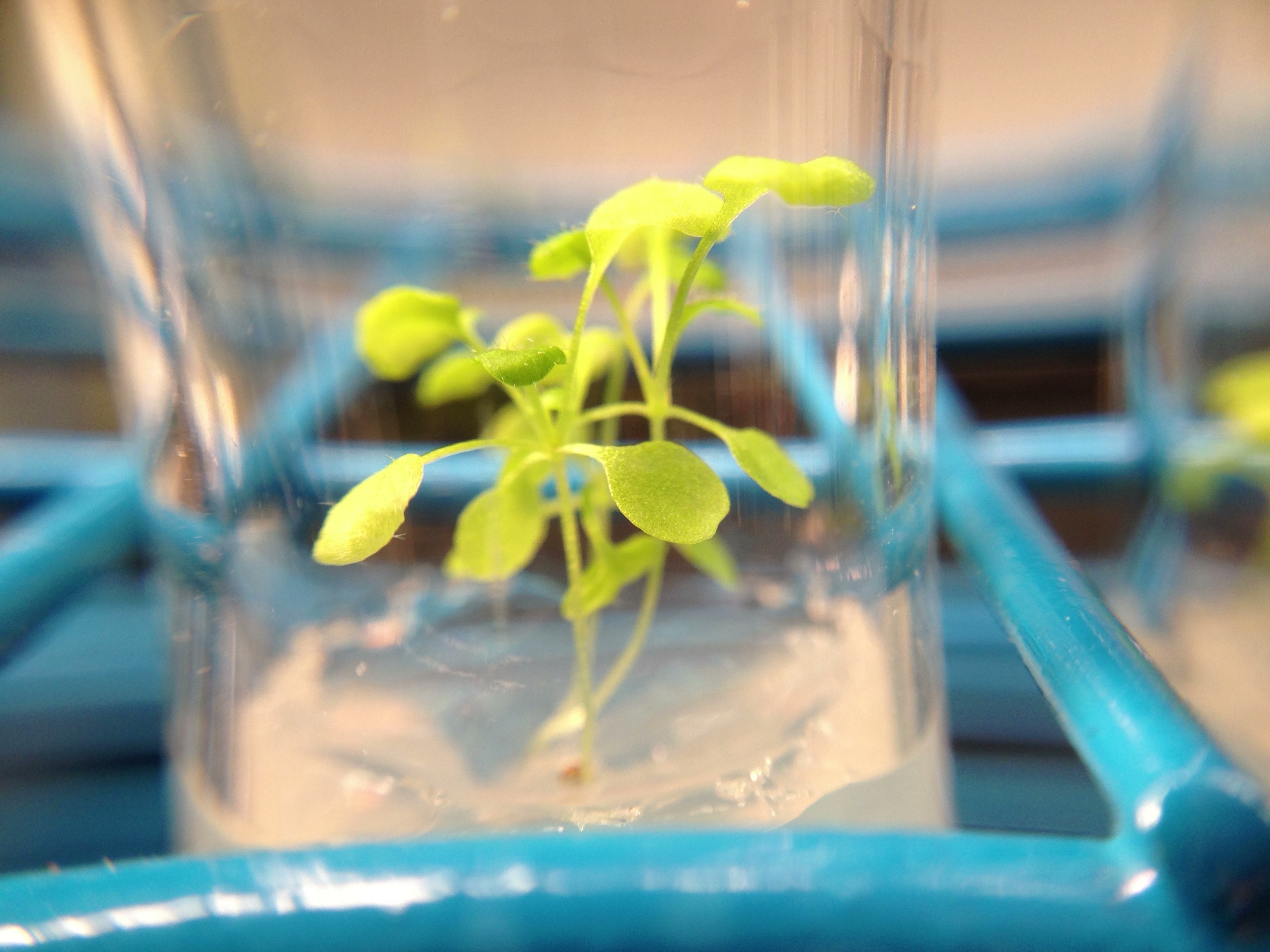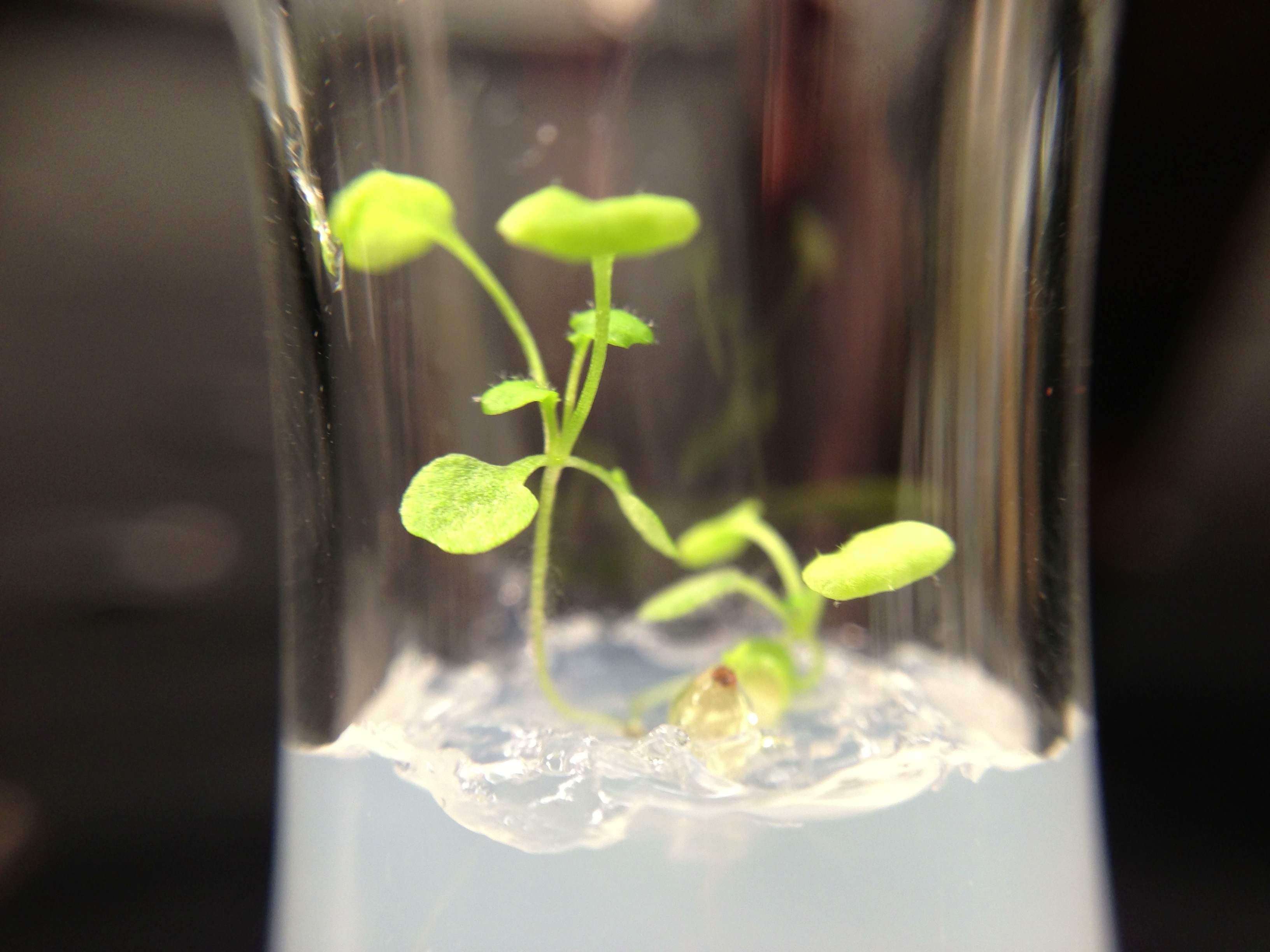Ever since I added a timed incandescent bulb to the system, the plants have been flourishing! That’s a gross over exaggeration, but they’ve been growing faster and better than prior. Check them out! I think next week I’ll add some 20% D2O plants and start charting their growth.
Tag Archives: d2o effects on life
Arabidopsis Growth
I haven’t inspected deeply, but a lot of the seeds in all my samples have started to sprout. This is good news indeed 🙂
Growing Arabidopsis!
It was discussed a long time ago that adapting arabidopsis to D2O could reveal some interesting finds. So in an effort to do that I’m going to grow some example plants to test the setup and try and produce seeds.
The one issue I worry about is evaporation. Since this cannot be stopped, evaporation could become a costly component of the experiment (D2O and DDW cost about ~$100 per 100ml). The first experiment will be using DI water. Here is my setup:
- This is based on the combination of these two protocols:
- http://www.biosci.ohio-state.edu/~plantbio/Facilities/abrc/handling.htm
- http://www.biologyteacher.uconn.edu/tips_arabidopsis.html
- I mixed 0.2192g (4.3g/L) of MS salt with 50ml of DI water.
- I then put 30ml in a beaker with 0.5g of agar, heated, and stirred. I was supposed to make 1% gel and measured 0.5g for the 50ml that I made instead of for the 30ml that I added to the beaker. When the agar dissolved, I added 10ml of MS salt water to the solution to reduce the gel percentage (now at 1.25%).
- I then put the MS agar solution in test tubes: 2 @ 1ml each, 2 @ 2ml each, 2 @3 ml each, and 2 @ 5ml each. I also put ~4ml into some random (but clean) glass jar thing. I bought these a long time ago when I was looking at clear, glass jars for the tobacco and arabidopsis seed DDW experiments. The reason for the various volumes is to determine how much medium the seeds need to grow efficiently and healthily.
- While I waited for the MS salt-agar solution to cool (and thus solidify) I poured a bunch of arabidopsis seeds into a petri dish and added some DI water to it. I did not steralize these seeds, because I’m just timing the growth and learning about the pollination process and judging how well the seeds will grow in the lab. For the actual experiments I will steralize the seeds.
- Once the growing media cooled, I used a pipetter to collect a few seeds (~5 seeds per sample) and place them in each sample. There are two sets of test tubes (one volume of each set, ie 1ml, 2ml, 3ml, 5ml).
- For the first set, seeds were placed on top of the growing medium.
- For the second set, seeds were plunged into the gel.
- For the random 4ml jar, seeds were plunged into the gel.
- Once seeds were set, rubber stops were placed over top of the test tubes to minimize evaporation.
I’m sure this process has tons of kinks, which will be worked out when the real experiment begins, but this is the purpose of an experiment right?
Yeast Time Trials in DI, DDW, and D2O: Trial 5 Results
Via figshare:
Yeast Hourly Growth in DI, DDW, and 99% D2O. Anthony Salvagno. figshare.
Retrieved 21:15, Jul 03, 2012 (GMT)
http://dx.doi.org/10.6084/m9.figshare.92771
Notes:
- I had a meeting this morning regarding the IGERT I speak so frequently of. That means the timed data wasn’t so consistent in the beginning. I took my first time point about 25 minutes after I set up the experiment. And then I took my second time point 2 hours later. The raw data will show that I took the first time point about 20 minutes later, but I assure you the time difference was more than that.
- I did take the rest of the time points an hour apart.
- I spilled a considerable amount of the D2O sample (which was in the beaker), maybe like 30-40% of it after I took the first time point.
- In data news, I find it really strange that the yeast in D2O didn’t grow nearly as much as it did in the past. I’m wondering if the new setup had anything to do with that.
- Also it looks like yeast in DDW grew more than the yeast in DI. Again I’ll have to do another run to verify, but I feel like this could be a real result.
- The added volume definitely improved the results, as the yeast remained suspended in the flasks. In the previous trials I would get considerable settling because the test tubes wouldn’t swirl as much. Much better setup.
So the moral of this story is, I’ll have to do another trial of this setup. Fine by me! Whatever it takes to get good results that are repeatable. That’s the nature of open notebook science!
Yeast Time Trials in DI, DDW, and D2O: Trial 5 Setup
I set up the starter cultures yesterday. Today is the day to track the growth over time. The only differences between this experiment and the ones I’ve done in the past is that this time I’m: (1) using higher volumes of YPD (total of 25ml) and (2) only doing three samples (DI, DDW, and 99% D2O) instead of the normal five (DI, DDW, 30%, 60%, and 99% D2O). I just didn’t have enough made YPD to do the other two samples.
Here is my setup:
- I’m using 2 small flasks and 1 small beaker. I only have 2 flasks so the beaker is an improvisation. I think they are all 50-80ml beakers/flasks but I’ll have to verify this. (Update: They are all 50ml glassware.)
- I added 22.5ml of each YPD type to the glassware.
- I added 2.5ml of each YPD starter culture to the glassware + YPD
- Put in the incubator/shaker at 125rpm and 30C.
- Record absorbance every hour.***
- blank with each type of ypd (ie measure the DI YPD culture after blanking with DI YPD, etc).
- I’m using semi-micro cuvettes and measuring with a NanoDrop 2000c (see experiment products page)
***I had some meetings this morning so my first time point is a half hour after I started incubation. And my second time point is 2 hours later. Every point after that is 60 minutes apart. See data for explanation.
Yeast Starter Cultures for Higher Volume Time Trial:Trial 5
Today I’m starting another starter culture for what will be the 5th experiment in this series of experiments. I’ve been getting mildly consistent data so I’m amping up production (in the form of volume) to see if the results change or become more consistent. I say mildly because the results across all experiments are similar (DI and DDW grow the most and then there is gradual declines in growth as D2O is added). But on a deeper level, time points typically cross paths or absorbance numbers decline temporarily. I’m hoping that it is the nature of the setup of the experiments as they are now, and that by increasing the volume of YPD for growth, there won’t be these minor inconsistencies. We’ll find out though!
Setup:
- Prepare 3 autoclaved and cleaned test tubes for YPD addition.
- Add 10ml of DI, DDW, and D2O YPD (that is YPD diluted in each water type) to each test tube.
- Inoculate a cell culture in each test tube.
- Place starter cultures in incubator/shaker at 30C and 150rpm.
- Check the next morning
Yeast Hourly Growth Trial 4: Results
Via FigShare:
Yeast Hourly Growth in DDW, DI, 30%, 60%, and 99% D2O. Anthony Salvagno. Figshare.
Retrieved 20:23, Jun 21, 2012 (GMT)
http://dx.doi.org/10.6084/m9.figshare.92564
A quick note: It seems the growth increases steadily over time, but the accumulation of cells on the bottom of the test tubes is both annoying and startling. This affects the readings and explains why the growth increases dramatically across the board between hours 3 and 4 (when I mixed the test tubes before putting 400ul in the cuvettes for measurement). Maybe using larger volumes would be helpful?
Yeast Hourly Growth Trial 4: Setup
Finally the starter cultures worked! But not really in the way that I expected. The stuff that was two days old grew and none of the new cultures that I started yesterday grew. Well at least I have something to work with today. Here is my experimental setup:
- Setup of five samples:
- 9ml of DI YPD + 1ml of DI starter culture
- 9ml of DDW YPD + 1ml of DDW starter culture
- 7ml of DDW YPD + 2ml of D2O YPD + 1ml of D2O starter culture (30% D2O sample)
- 4ml of DDW YPD + 5ml of D2O YPD + 1ml of D2O starter culture (60% D2O sample)
- 9ml of D2O YPD + 1ml of D2O starter culture (99% D2O sample)
- Measuring:
- 400ul of each starter culture in semi-micro cuvettes – to measuring starting absorbance
- 400ul of each timed culture (the samples to be measured over time) in semi-micro cuvettes – to measure the time=0 value (should be close to 1/10 of the starting measurements)
- repeat B every hour
- Blanking:
- Before each hourly measurement you need to blank the nanodrop
- Blank the DI samples with DI YPD (no yeast added)
- Blank the DDW samples with DDW YPD
- Blank the 99% D2O, 30% D2O, and 60% D2O samples with D2O YPD
Starter Cultures Failed Again!
So of the 6 starter cultures I made (2 of each water type: DI, DDW, D2O) only one sample grew and interestingly and amazingly enough it was the D2O sample! Well today I’m giving it one more go.With the same setup, just using a fresh batch of yeast. The yeast I bought from ATCC.org came in some solution, and I created about 20 aliquots from that solution. So from one aliquot I inoculated 4 new samples (2 DI, 1 DDW, and 1 D2O). And I streaked some from this aliquot one an agar plate.
On top of that I inoculated some of the yeast that had grown in the 1 YPD D2O culture into all the failed cultures. I just want to see if they’ll grow from an established colony.
Let’s see what happens tomorrow.
Starter Cultures Try 2
Yesterday’s starter cultures failed to produce anything, so I am trying again today with my fresh YPD broth. Same protocol:
- Inoculate 1 colony in one of three samples (YPD with DI water, DDW, or D2O).
- Place in incubator/shaker at 30C
- Wait
Hopefully tomorrow I’ll have better results.

